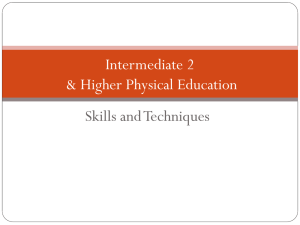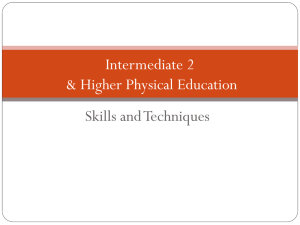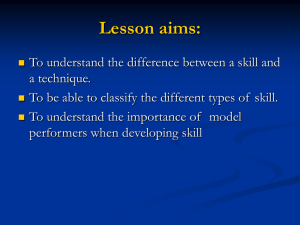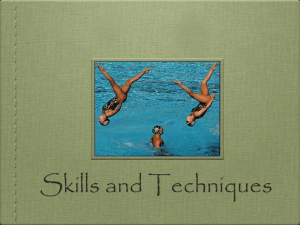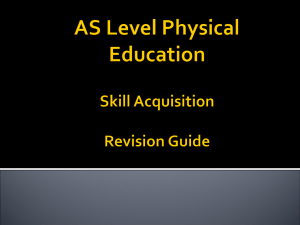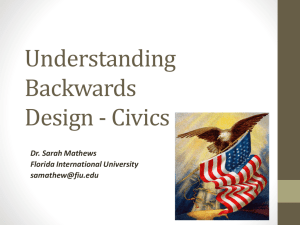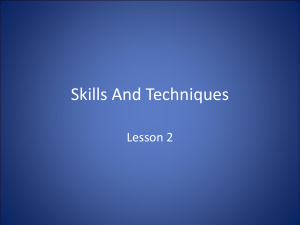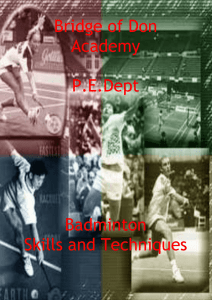Skills and Techniques - Kirkintilloch High School
advertisement
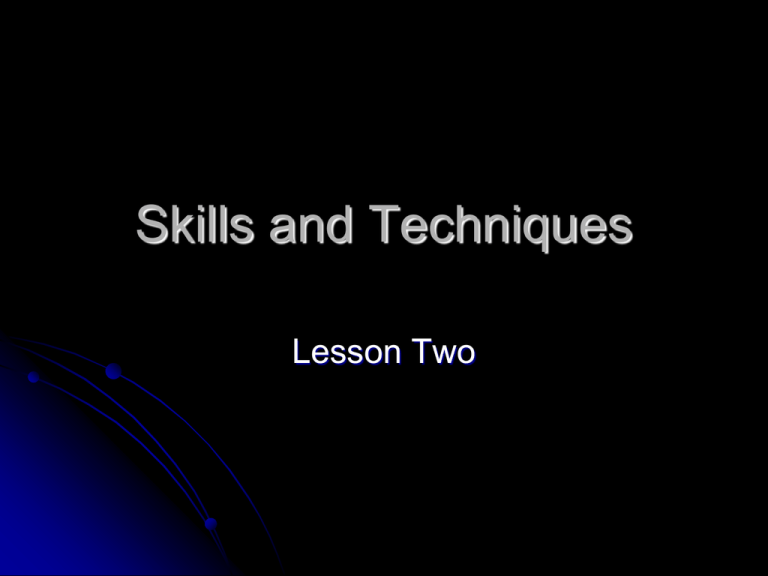
Skills and Techniques Lesson Two Today we will… Undertake a marking task. From the feedback improve on homework answer. Identify Explain stages of skill learning. what you did at the preparation (cognitive) stage of skill learning. Homework Feedback Initial Comments Number of people failed to submit homework on time. Demerits/Letters/Phone Calls home. Some people have to redo the question on data gathering as it wasn’t up to the standard required for their level of course presentation. Redo homework due tomorrow – Tuesday 23rd Homework Due Wednesday 17th November Question 1: Explain the benefits of considering a model / skilled performance when learning or developing this skill or technique. Using the key content below mark your homework answer to question 1. Decide whether it’s Green/Yellow/Red. Use the key content to improve your answer. At the cognitive stage of skill learning. Limited ability and knowledge of skill. Observing Model performer helps improve knowledge of what it means to perform effectively. Some skills and techniques are difficult to carry out effectively. Watching a top level performer playing the shot, possibly from a slow-motion video, can assist you in learning how to perform the skill effectively. Seeing someone else perform to a high standard gives you a clear picture of what it is you are striving to do. At first the skill may seem overwhelming however observing model performer can make performance look exciting and motivate you to improve. Comparing your performance to a model performer enables you to identify strengths and weaknesses in own performance. For example using movement analysis (PAR) make comparisons between your performance and that of the model performer. Comparing yourself with a model performer provides you with different types of feedback. Can plan appropriate practice/set measurable & achievable targets help you monitor progression and keeps you motivated. Working with a model performer also has benefits Provide you with accurate feeds during practice. Ensures high quality effective practice. They can give immediate feedback, helping eliminate errors early on. Can provide you with challenge/competition during practice sessions. Section One (General Data Collection) Compared my court movement during competitive games to that of a model performer. Analysis Of General Performance Assessed the variety and effectiveness of my strokes in a competitive game. Feedback Didn’t fully describe observation schedules, give specific examples of what was assessed. Describe fully how observation schedules were completed. 3 games/15 points/opponents of similar ability. Didn’t explain what you found out from observation schedule Explain why methods used appropriate. Section Two (Specific Data Collection) Assessed the accuracy of overhead clear in closed environment using hoop test. Assessed placement of overhead clear during competitive game (open environment) using scatter diagram. Observed video of model performer to develop knowledge and understanding of the subroutines involved. Broke overhead clear down into preparation, action, recovery. Compared overhead clear to that of a model performer using movement analysis observation schedule. Feedback Didn’t explain which test was carried out in a closed environment and which was carried out in an open environment or explain why it was important to test in both. Didn’t fully explain how compared performance to that of a model performer and why this was appropriate Didn’t explain what you discovered from observation schedules Now that we have worked out the demands of the skills involved in badminton and assessed our strengths and weaknesses we are now in a good position to develop our identified weakness. There are three important stages in learning and developing skills STAGES OF LEARNING Preparation (Cognitive) Practice (Associative) Automatic (Autonomous) Cognitive Stage During the planning stage, you find out what the skill involves – work out the subroutines. Preparation Action Recovery Even although some of the subroutines involved in the skill maybe new, it does not mean that you are at the beginner level in badminton. Beginner Level Badminton Player After establishing the different subroutines you make your first attempts at learning the skill Errors are likely to be common during the planning stage. As a result of this you will need lots of advice and encouragement What was the first thing you did during the cognitive stage? During the cognitive stage, I found out exactly what the overhead clear involved. To do this I observed a model performing playing the stroke. I was then able to break the skill down into three phases these were: Preparation Action Recovery Why did you break the OHC down? This enabled me to identify each of the subroutines that make up the skill. By doing this I had a clear understanding of the movements I had to perform in order to play an effective overhead clear. Even although some of the subroutines involved in the overhead clear were new, I wasn’t a badminton beginner, I had some previous experience of the activity. What did you do after establishing the subroutines? After establishing the subroutines involved I made my first attempts at performing the skill by shadowing the movements of a model performer, to do this I used shadow practice. As my performance improved I attempted different shadow practices which got progressively more difficult. It was important to ensure my practice was progressive to keep the practices challenging and prevent boredom. Why was it important to receive feedback at this stage? During these early stages I made a lot of errors, for this reason it was important that I received regular positive feedback. By receiving regular verbal feedback from my partner I could very quickly correct errors in my performance. Due to the number of errors I initially made it was important the feedback was positive to keep my motivation levels up. During the cognitive stage, I found out exactly what the overhead clear involved. To do this I observed a model performing playing the stroke. I was then able to break the skill down into three phases: Preparation Action Recovery This enabled me to identify each of the subroutines that make up the skill. By doing this I had a clear understanding of the movements I had to perform in order to play an effective overhead clear. Even although some of the subroutines involved in the overhead clear were new, I wasn’t a badminton beginner, I had some previous experience of the activity. After establishing the subroutines involved I made my first attempts at performing the skill by shadowing the movements of a model performer, to do this I used shadow practice. As my performance improved I attempted different shadow practices which got progressively more difficult. It was important to ensure my practice was progressive to keep the practices challenging and prevent boredom. During these early stages I made a lot of errors, for this reason it was important that I received regular positive feedback. By receiving regular verbal feedback from my partner I could very quickly correct errors in my performance. Due to the number of errors I initially made it was important the feedback was positive to keep my motivation levels up. Homework • Due Friday 26th Nov Task 1: Describe what you did at the cognitive stage of skill learning to develop your overhead clear. Give specific performance related examples to support your answer. Task 2: Describe a complex skill which you found to be a weakness. Explain why you considered it to be a weakness. Answer should include • Intro – aim/objective of overhead clear • Explanation as to why OHC is a complex skill • Comparison of your performance to that of a model performer at the Preparation / Action / Recovery stages. • Summary of how this affected the effectiveness of your overhead clear.
